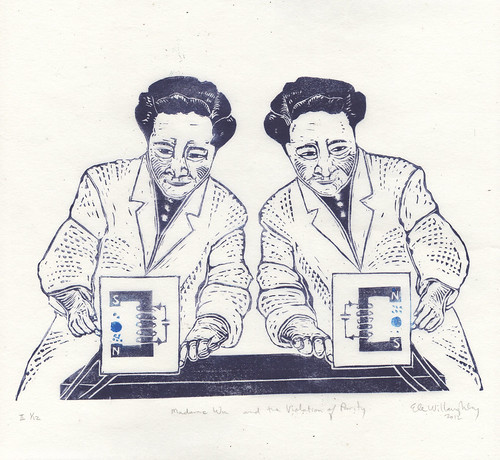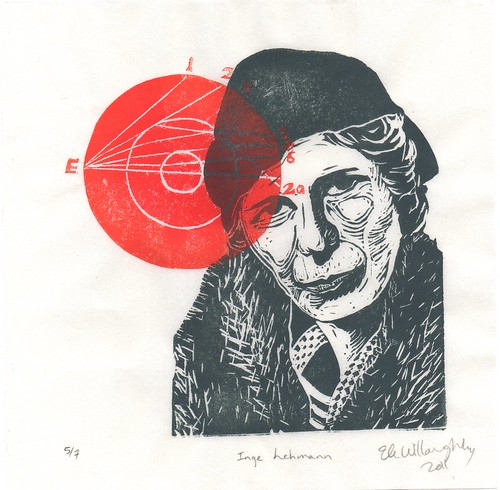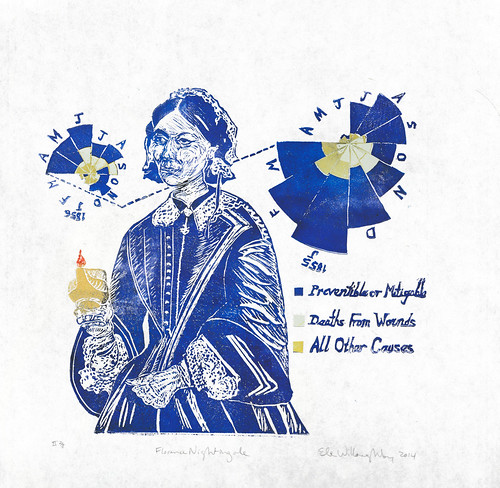 |
| Madame Wu and the Violation of Parity, 2nd ed. linocut, 2012, Ele Willoughby |
Happy birthday to Mme. Wu! Chien-Shiung Wu (May 31, 1912- February 16, 1997, Chinese-born American physicist, whose nicknames included the “First Lady of Physics”, “Chinese Marie Curie,” and “Madame Wu”) came up with a truly beautiful experiment to test whether the weak force conserves parity (whether beta decay would be the same if reflected in the mirror). In my print on the left I show Mme. Wu in her lab and a schematic diagram in the box of her beautiful experiment. On the right I show her reflection, as in the mirror, and in the box I show the mirror reflection of the experimental set-up and the shocking result, that the reaction is not the mirror opposite.
In 1956, theoretical physicists Tsung Dao Lee and Chen Ning Yang suggested that perhaps the weak force might not be the same 'through the looking-glass'. The idea that the "Law of Conservation of Parity" might be broken was hard to believe. The laws of physics are the same in the mirror for anything else. Face a friend, as in the mirror. If you drop a pencil from your right hand, and your friend mirrors you and drops a pencil with his or her left, the pencils will fall at the same rate. This is because Parity is conserved by the force of gravity - as it is with the electromagnetic force and even the strong (nuclear) force within atomic nuclei. Lee and Yang pointed out that no one had checked to make sure that the weak force, which controls beta decay in radioactive materials, also conserves parity. Lee convinced the brilliant experimentalist to test this.
Madame Wu did a subtle and technically difficult experiment with her collaborators which is shown schematically in the print. She took Cobalt-60 (shown as the cobalt blue sphere in the box), which is radioactive. Its neutrons spontaneously give off electrons and become protons. The electrons are the tiny blue dots. On the left, we see that the Cobalt-60 in an electromagnet (a wire wrapped metal horseshoe with a source of power). Because of the spiral-wrap of the wire, we know that the North pole of the magnet will be on the bottom (you can figure this out by mimicking the curl of the wire with the fingers of your right hand and look at the direction your thumb points). It turns out that the emitted electrons are given off preferentially towards the North pole.
Next, she reversed the set-up as in the mirror. On the right you see the horseshoe and wire spiral reflected. If you use your right hand to check the direction of the magnet field, you'll see that it is the opposite way; the North pole is now on the top. It turns out that the electrons are preferentially emitted upwards toward the North pole. Thus, beta decay IS NOT the same in the mirror! Madame Wu showed that a "Law" of physics did not hold! This result was staggering and shocked the physics world. Lee and Yang won the Nobel prize for their theoretical work. Many physicists thought Mme. Wu should have been included in this win.
She won many honours for her incredible career. Wu took part in the Manhattan Project (she is believed to be the only Chinese person to do so) and literally wrote the book on beta decay. She was the first: Chinese-American to be elected to the U.S. National Academy of Sciences; Female instructor in the Physics Department of Princeton University; Woman with an honorary doctorate from Princeton University; Female President of the American Physical Society, elected in 1975; winner of the Wolf Prize in Physics (1978); Living scientist to have an asteroid named after her. She won many awards and fellowships including: the Research Corporation Award 1958; the Achievement Award, American Association of University Women 1960; John Price Wetherill Medal, The Franklin Institute, 1962; Comstock Prize in Physics, National Academy of Sciences 1964; Chi-Tsin Achievement Award, Chi-Tsin Culture Foundation, Taiwan 1965; Scientist of the Year Award, Industrial Research Magazine 1974; Tom W. Bonner Prize, American Physical Society 1975; National Medal of Science (U.S.) 1975; the aforementioned Wolf Prize in Physics, Israel 1978; Honorary Fellow Royal Society of Edinburgh; Fellow American Academy of Arts and Sciences; Fellow American Association for the Advancement of Science; Fellow American Physical Society. And I bet you hadn't heard of her! I'm trying to redress that.

















